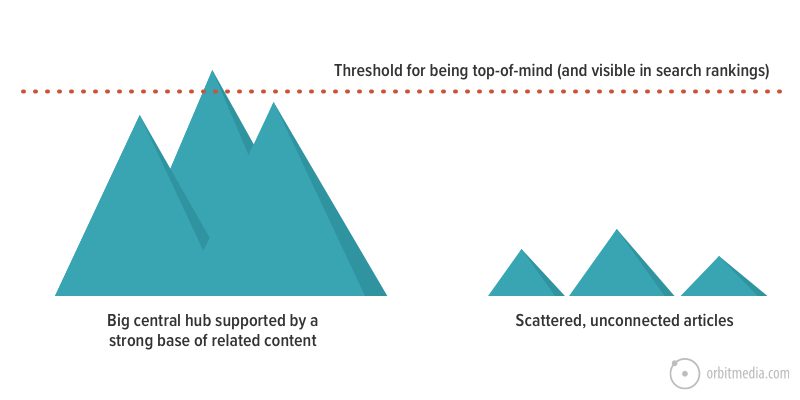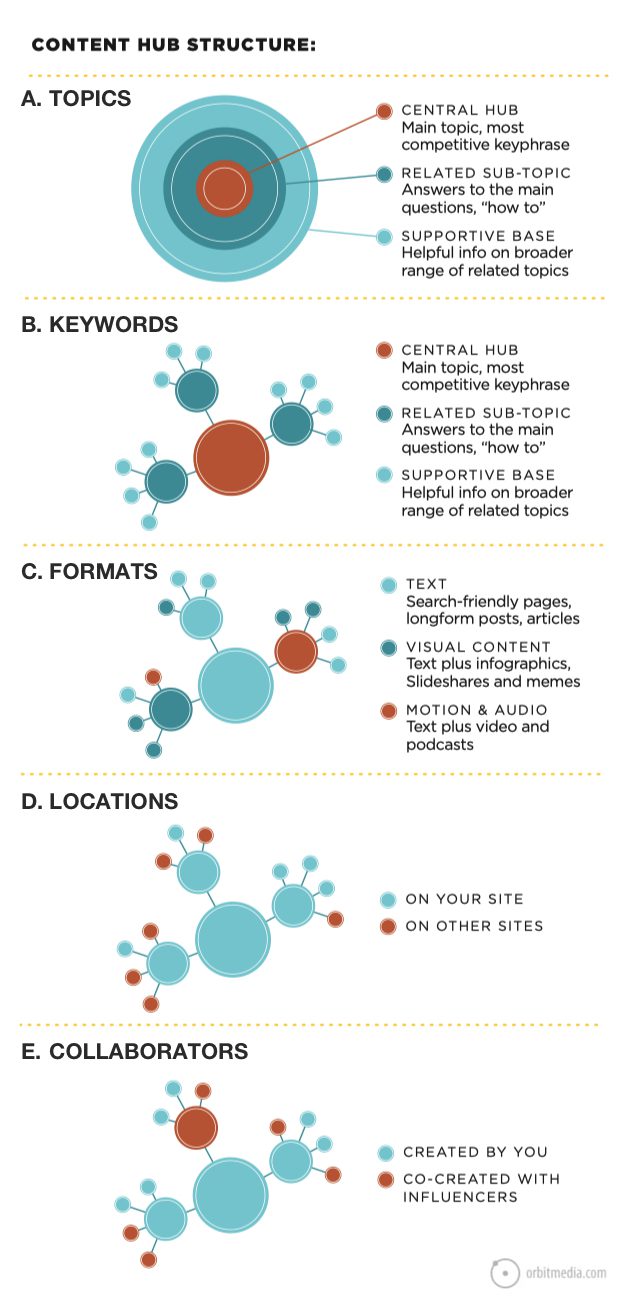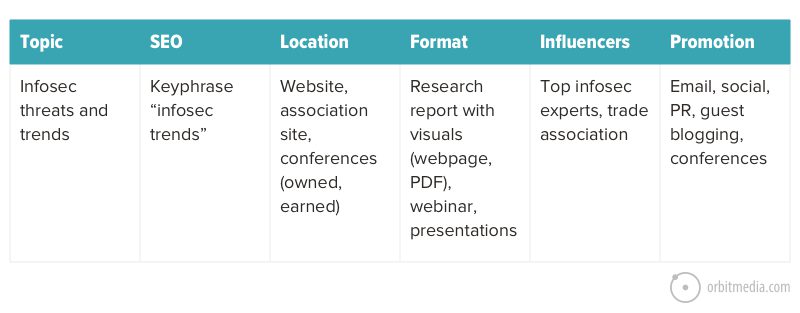Competition for attention online is fierce. Literally, millions of articles are published every single day.
But take a moment to think about the nature of that competition. Competition is specific to topics. In Google, in social media, and in the minds of your audience, the battle for attention is fought topic by topic.
Some categories and topics, like HDTVs and mattress reviews, are insanely competitive. They’re crowded with famous blogs and big companies that have invested in content for years.
They’re impossible.
Other topics, such as hedgehog tricks and telescope repair, are not competitive at all. A small player can win attention, but these niches are so narrow that you can’t generate enough visibility to thrive.
They’re useless.
So how can you compete and win against the big players for more valuable topics?
No matter the arena, the winner is winning because they have a large body of high-quality, interconnected content, focused on their specific topic, with a body of work that covers all of the related subtopics. They are totally focused on satisfying the specific information needs of their specific audience.
So to beat the established players, you need to be focused and structured, building up a body of work around a specific topic. You need to build a hub of content.
- DON’T: Build a pile of medium-quality blog posts that all say similar things.
- DO: Create a well-organized collection of diverse, interconnected assets, in many formats, in many places, co-created with influencers.

When a brand stays focused on a topic, it’s as if the content builds up, reaching high above the competition and gaining greater visibility. Like a mountain, with a central peak surrounded by a wide base of subtopics.
But many marketers just aren’t that focused. They publish a bit here and a bit there, deciding what to write based on whim, not publishing a strong central piece, not staying on a topic for long and not connecting content in strategic ways.
They create small hills that never rise high enough to be visible.
 |
Joanna Wiebe, Founder, COPYHACKERS“We’d been blogging for about a year when we published our first cornerstone piece: a blog post on every copywriting formula ever. We’ve updated that post every year since. And around it, we’ve published related posts – on our site and off it – plus created videos and webinars on copywriting frameworks, copywriting formulas and conversion copywriting. Everything connects together but isn’t so tightly connected that it all feels the same.“ |
Elements of a content hub
A content hub is a set of content organized around a specific topic and a central page. That page is typically a very detailed article or a sales page promoting a product or service. In either case, the central piece is search optimized and targets a relatively competitive phrase. Sometimes it’s designed to capture email addresses through gated content.
These pages are sometimes called “pillar pages” or “cornerstone content.” It’s all the same idea.
The content pillar piece is surrounded by articles that support that piece in multiple ways. Here you are simply combining the various approaches in a structured, organized way.

A. Content on interrelated topics
The posts or pages support each other, inviting the visitor to dig deeper through internal links, like a mini-version of Wikipedia. This triggers longer visits and gently guides visitors toward the center.
B. Content targeting related phrases
The center of the hub targets the broadest, most popular, most competitive keyphrase. It is supported by many pages that target more specific, related phrases, forming a large set of internally-linked keyphrase-focused pages.
C. Content in various formats
The structure includes many formats from the Periodic Table of Content. It goes beyond blog posts and includes infographics, guides, videos, original research or even audio.
D. Content published on other websites
Not all of the content is on your website. Some of the articles are bylined articles and guest posts, published on other websites. Others may be published on other platforms, such as YouTube and LinkedIn.
Especially in the beginning, before you’ve built up your audience. Content published on other sites will increase your visibility (and increase your Domain Authority) fast.
E. Content co-created with influencers
The content isn’t created in isolation. It is collaborative, co-created with relevant influencers and media partners. These may be bloggers and editors, podcasters and journalists and anyone else who has already built an audience that you’d like to reach.
How to build a content hub in 7-steps
This approach requires forethought, planning and persistence. Some content strategists build a hub each quarter and plan the rollout using a publishing calendar. Depending on the topic, this process may take much longer.
1. Pick a topic that’s valuable to you and important to your audience.
Think about the questions your content can answer, the problems your business solves and the phrases your audience is likely to search for. Make a list of these questions, answers and keywords. They should be closely related.
2. Check the competition for the main phrases
Check your own Domain Authority and use MozBar to see the Domain Authority of the high-ranking sites for your main topics and keywords. In other words, do your keyword research.
Normally, you’d need an authority in the high end of the range of the other high-ranking sites for the phrases you’re targeting. But since we’re building an entire hub of content, we have a chance of eventually winning for those valuable, out-of-reach phrases.
3. Connect with and collaborate with relevant influencers
Build a list of potential collaborators and work to slowly win their attention and respect. Or use social media to find experts in this niche. Join groups, go to events and comment on blogs. And when the time is right, reach out and ask if they’d like to contribute to your content project.
4. Publish the central hub
It’s time to go big. Create a piece of content that you sincerely believe to be the best page on the internet for the topic. Make it detailed and comprehensive, practical and visual. Original research is a great way to anchor a content hub (see examples here). All the content around it makes the link-worthy center more visible.
Below you’ll find two examples of content that fits in the center, one B2B and one B2C.
5. Publish supportive content in various formats
Start publishing on the related subtopics. Write articles that answer the related questions. Start publishing in various formats. Produce an infographic and video. Keep publishing, linking each piece back to the center. Whenever possible, use the target keyphrase of the central hub in the text of these links.
6. Publish on other websites
Pitch related posts to relevant blogs, trade publications, association sites and the local media. Write about the topic on Medium and LinkedIn. Answer related questions on Quora. These could be alternate versions of content you’ve published, repurposed and rewritten. And always, link back to the hub.
7. Stay focused, watch your rankings and check Google Analytics 4 (GA4)
As you keep building and promoting, you’ll eventually see growth in traffic and engagement. GA4 will show a slow, steady increase in search traffic with spikes of social, email and referral traffic each time something new is published.
If you’re not winning, you’re not done yet. Keep building. If you are winning, congratulations! You are now relevant. Build it up even higher or go start another content hub.
Examples of content hubs
Here are two examples, one B2B and one B2C, of the kind of content that works within a content hub. Both are mini-content programs that fit well within a larger structure. They are not random acts of marketing. They connect all the dots across formats, locations, influencers and channels.
B2B example: Information Security Company
This service provider has a content strategy with two goals:
- Increase awareness/trust among infosec professionals
- Improve Domain Authority by attracting links and eventually rank for infosec related phrases
Rather than simply making an industry report, they have a more comprehensive plan:
- Conduct a survey of 200+ cybersecurity experts to discover top threats and trends
- Conduct brief interviews with five of the most respected experts
- Partner with an association or trade publication to publish a detailed (and visual) industry report filled with insights from the survey and quotes from the experts
- Encourage the partner and collaborators to share and link
- Repurpose the content: produce a short webinar series based on the data and pitch a presentation for industry conferences
- Repeat annually
Notice how all of the elements of content strategy are covered:

B2C example: Nonprofit Nature Conservancy
This donor-driven cultural institution has a content strategy with two goals:
- Increase awareness and attendance for spring programs
- Grow social followings and your email list to support future fundraising among small donors
Rather than simply posting photos to social media, they have a more comprehensive plan:
- Reach out to a well-known photographer, invite them to be the judge in a photo contest
- Gather submissions from Instagram using a new hashtag
- Ask a local news anchor to host a live broadcast on Facebook/Instagram to announce the winners
- Post galleries of winning entries on a webpage with strong email signup CTA
- Pitch it as a news story to the local media for their program …a natural fit since they’re already working with the anchor, right?

It’s easy to imagine how effective these strategies would be. The influencers are fully integrated and the content promotion is built-in. Content at this level isn’t possible without collaboration.
Nothing is hard or easy. But some things take longer than others
Visitors might never notice the structure of what you’ve built, but it doesn’t matter. This content strategy helps you in all the most important ways.
 |
Bruce Lee, Kung Fu Legend“I fear not the man who has practiced 10,000 kicks once, but I fear the man who has practiced one kick 10,000 times.“ |
Search benefits
Ever seen a little website outrank a big brand? It is possible. Usually, it’s because the big brand was ranking by accident. They have a page that’s relevant and a domain that’s authoritative. But the smaller player wins because they have built up a set of highly-focused, interconnected pages.
If you’ve been blogging for a long time, but you’re not getting much search traffic, this may be the problem. You’re not deliberately creating groups of content organized around central topics.
Social benefits
Your social stream is a curated list of posts. If this stream has a specific focus, you’ll gradually win followers and earn attention from people who share that interest. You’ll also build relationships and friendships with relevant influencers, creating more opportunities to collaborate.
Email marketing benefits
The center of the hub may feature some high-value gated content. Visitors may be willing to share an email address to access this “content upgrade” or “lead magnet.” Or you may trigger a popup offer to the subscribe on the second or third article they read during their visit.
Engaged visitors
When a visitor comes to learn about something, one page may not be enough to satisfy them. But if they find themselves within a larger hub they’ll likely dig deeper. This increases the average number of pages per visit and average time on site.
Give them more and you’ll keep them longer. Eventually, when people ask, “What was that site that had all that great information on this topic?” they’ll think of you and come back. This is how a brand becomes relevant in search engines, on social media and in email inboxes. Eventually, this is how brands become top-of-mind.




